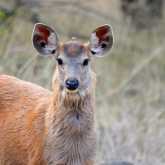Sambar deer
Alert
Have you seen Sambar deer?
Be on the lookout for Sambar deer and report it to Biosecurity Queensland. Early detection and reporting are the key elements in preventing Sambar deer from becoming a major problem in Queensland.
Call us on 13 25 23.

Juvenile sambar deer
© Nidhi.pious996Creative Commons

Mature sambar deer
© Rudraksha ChodankarCreative Commons

Sambar deer side view
© Revati SarnaikCreative Commons
Native to the Indian subcontinent, Nepal and Sri Lanka, sambar deer are the largest deer found in Australia. Deer from Sri Lanka were originally released in Victoria in 1863; later releases came from India. This means the Australian population has mixed genetics from different sambar subspecies. As solitary animals they are not suitable for commercial deer farming, they can damage native and cultivated vegetation and pose a hazard to vehicles.
You must not move, keep, feed, give away, sell or release sambar deer into the environment.
You must report all sightings to Biosecurity Queensland within 24 hours.
Scientific name
Other names
- Axis deer, Indian spotted deer
Similar species
Description
- Large deer species, with stags standing about 130cm tall at shoulder and weighing up to 300kg, hinds smaller 115cm and weighing about 230kg.
- Coat is thick with a uniform brown colour.
- Throat, inner legs, stomach are light-buff colour.
- Ears are prominent, bat-like with light-buff inner colour.
- Tail is 25–30cm long, black with whitish underside.
- Stags carry 3-tined antlers, the outer top tine is usually the continuation of the main beam while the inner top tine is somewhat shorter, usually around 120cm long.
- Stags sound a loud honk when alarmed.
Habitat
- Prefers tropical or subtropical climates.
- Adapts to a wide range of habitats, primarily living in woodland forests.
Distribution
- Not found in the wild.
Life cycle
- Lives solitary.
- Breeding is non-seasonal, with seasonal peaks in May–June and from September–November.
- Adult hinds give birth after gestation of about 243 days.
- Usually only has a single calf, twins are rare.
Crops affected
- Agricultural crops, pasture, forestry plantations, gardens.
Impacts
Environmental
- Can damage natural environment by eating native vegetation, damaging trees, dispersing weed seeds, and fouling water.
Economic
- Can damage forestry seedlings, agricultural and horticultural crops, commercial flower crops, orchards, irrigation systems, and fences.
- Sometimes selectively consumes new growth and ringbarks orchard trees, leading to reduced orchard viability.
- In dry seasons, competes with cattle for pasture and supplementary feed.
Social
- Can be traffic hazard and cause car accidents in rural areas (generally not found near urban areas).
Control
- Before undertaking any preventative or control actions, contact our customer service centre.
Shooting
- Shooting must be carried out by trained personnel with appropriate firearms licences. Shooters must possess necessary skill and judgment to kill deer with single shot. Lactating females should not be targeted but, if they are inadvertently shot, young should be found and euthanased.
Ground shooting
- Although time-consuming and labour-intensive, ground shooting is the most effective and humane technique for reducing deer populations. Usually done at night from vehicle with spotlights.
Helicopter shooting
- Helicopter shooting is effective in inaccessible areas such as broadacre crops, swamps and marshes. However, most new deer populations in Queensland are at comparatively low densities and in areas of thick cover where helicopter shooting is unlikely to be an economical option. Helicopter shooting also risks disturbing and dispersing deer populations.
Trapping
- Trapping may be an option for deer control in some circumstances. Simplest form involves self-mustering trap.
- Traps must be monitored and deer promptly tranquillised or euthanased after trapping. Deer mortalities of 3-7% post-trapping have been recorded in US studies, and animal welfare issues must be considered when using this method.
Legal requirements
- The sambar deer is a category 2, 3, 4, 5 and 6 restricted invasive animal under the Biosecurity Act 2014.
- You must not move, keep, feed, give away, sell or release into the environment.
- You must report all sightings to Biosecurity Queensland within 24 hours.
- You must take all reasonable and practical measures to minimise the biosecurity risks associated with dealing with sambar deer under your control. This is called a general biosecurity obligation (GBO).
- At a local level, each local government must have a biosecurity plan that covers invasive animals in its area. This plan may include actions to be taken on sambar deer. Some of these actions may be required under local laws. Contact your local government for more information.
Further information
- Contact the Customer Service Centre